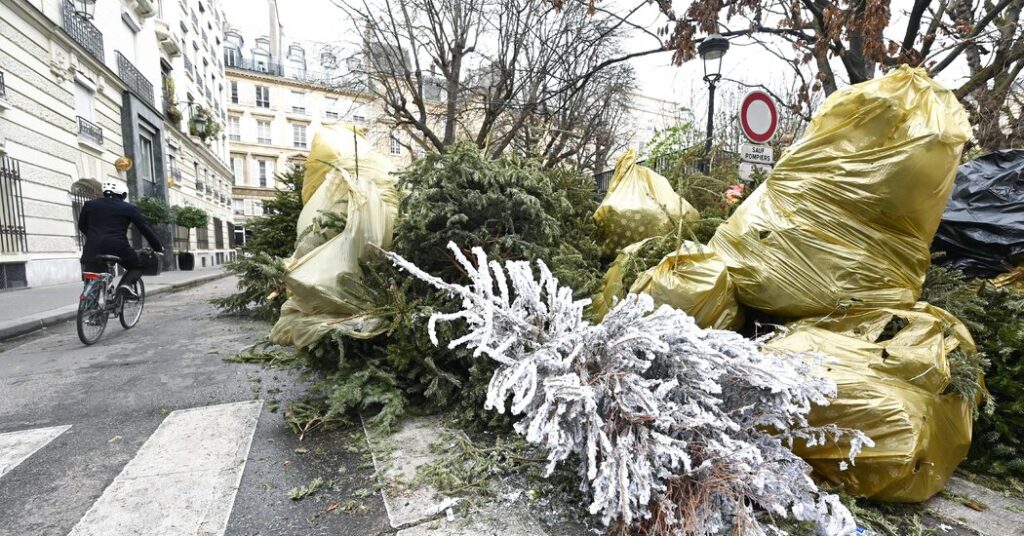Dreaming of a less wasteful holiday
5 min read
It’s the season of parties, gifts and lots and lots of food. It’s also the season of buying more than we can use or eat, and then throwing it away.
Household garbage tends to increase around 25 percent in the weeks between Christmas and New Year’s Day in the United States, according to the Environmental Protection Agency. The same is true in Canada and other countries.
And that’s not counting the stuff we will throw away in the near future, like a cheap T-shirt that falls apart after a few washes, or a plastic toy that quickly gets discarded.
While we often think of the world’s environmental problems as being primarily about the toll of fossil fuels on the climate, they are also about the burden created by the absolute tonnage of stuff we buy and consume — the packaging, the toys, the fast fashion, which are often made with petroleum byproducts, and moved around the world by burning fossil fuels. And that’s especially true of the holiday frenzy of presents and parties.
We can, of course, do a lot better: Buying well-made, durable goods, giving experiences instead of objects, minimizing food waste and composting the leftovers.
Being thoughtful is the first step, said Daniel Hoornweg, a professor at the Ontario Tech University who has been studying waste for four decades.
“When you buy something, think about where it came from and where it’s going,” he told me. “That’s half the battle.”
Moving the focus away from stuff
First, let’s look at some numbers.
-
The British waste 30 percent or more food during Christmas than at any other time of the year.
-
In Canada, 540,000 metric tons of wrapping paper and gift bags are thrown out after Christmas each year.
-
Holiday lights in the United States (as measured in 2008) consumed more electricity than El Salvador used in an entire year.
There is room for improvement. We can be more mindful of the recycling and reusing potential of what we buy, plan on how we will use leftovers, and buy LED lights, which last longer and consume 90 percent less energy than incandescent bulbs.
We can also move away from the need to buy so much stuff, by re-evaluating what we consider to be valuable.
Typically, the richer people are, the more household waste they generate. Wealthy people rely more packaged foods, discard more cellphones and buy more toys that will soon break.
The remedy may be giving a concert ticket instead of a gadget. (We have a guide for buying experiences rather than things from last year’s holiday season.)
A less wasteful lifestyle
There is no correlation between happiness and more stuff, as measured by waste generation, Hoornweg said.
While happiness is hard to measure, we can compare countries by their human development index, which covers many dimensions of quality of life, like income, life expectancy and access to education.
Take Japan and Canada. Canadians produce about twice as much waste per person than the Japanese.
Japan is a lot more dense, people have smaller homes and don’t need cars to travel great distances as much, while in Canada people have bigger cars, bigger houses and eat more at fast-food restaurants that come with several layers of packaging.
And yet, both countries have very similar human development numbers.
A lot of it comes down to culture.
My family is Brazilian, and we always serve multiple times the amount of food that is needed when we throw a party. My aunt’s husband, who is German, tries to serve roughly the amount that people will eat. When he cooks, the whole family collectively holds their breath in fear there won’t be enough food. But there always is.
Silpa Kaza, who studies waste at the World Bank, told me she once carried all her waste in her bag for a month to internalize how much she was producing. It made her more mindful.
“I was so conscious of every decision I made,” she said.
Today, she takes a collapsible container to a restaurant to bring leftovers home and no longer uses plastic produce bags in the supermarket.
She told me cities and countries can take into account culture to induce better behavior. For example, after South Korea implemented a collection system in the 1990s that charges people according to how much they throw away, total household waste generation fell by half.
We may need policies like that to change the trajectory of waste generation. Right now, it is expected to skyrocket from 2.24 billion tons in 2020 to 3.88 billion tons in 2050.
But a little mindfulness around the holidays is a good place to start.
Related:
Fears of a carbon market land-grab
The little-known Emirati company began by setting its sights on a forest the size of Maine. Then, another as big as South Carolina, then a chunk of land the size of Puerto Rico.
As the oil-rich emirate of Dubai prepared to host this year’s United Nations climate summit, the U.A.E. company Blue Carbon was accumulating proposed deals on huge swaths of land across the developing world. It sought to position itself as a force for a purported solution to global warming: carbon credits.
Carbon credits are potentially one of the most important — but also most controversial — tools to speed up efforts to reduce global emissions of heat-trapping gases.
The idea is simple: each credit is worth one ton of carbon dioxide emissions that was sequestered or avoided. Industrialized nations could buy credits as a way to offset their own emissions. The carbon trade could reduce emissions of greenhouse gases while sending funds to developing countries that badly need them to grow their economies sustainably.
In practice: It’s complicated.
Many conservationists worry that carbon markets could be abused by countries that want to continue to burn fossil fuels, or by bad actors looking to cash in without actually reducing emissions.
Some also say that deals with companies like Blue Carbon could strip local communities of their land rights. For instance, Blue Carbon’s draft contract with Liberia’s government, reviewed by the Times, shows the company wanted to secure the right to sell carbon credits from areas that are currently occupied by communities, private farms and reserves.
The company would pocket 70 percent of the proceeds — tax free for a decade — from the sale of any carbon credits related to the land. The government would get the remaining 30 percent, plus a 10 percent royalty over the value of each credit, half of which would go to local communities.
Environmentalists complained that local communities and the government were getting too little, and Blue Carbon was not disclosing enough.
“We said, ‘Halt the negotiation,’ because we need more consultation,” Loretta Alethea Pope Kai, a local activist, said she told government officials. “The deal was a bad deal.” — Manuela Andreoni and Max Bearak





